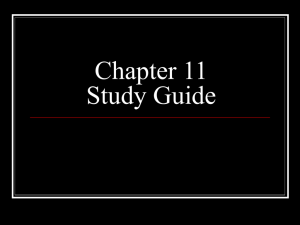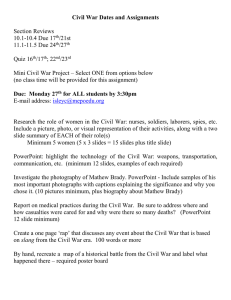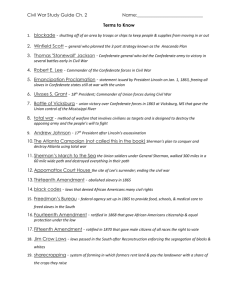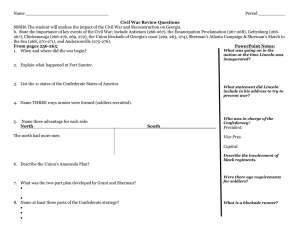U.S. History ch.11 powerpoint notes (Civil War)
advertisement
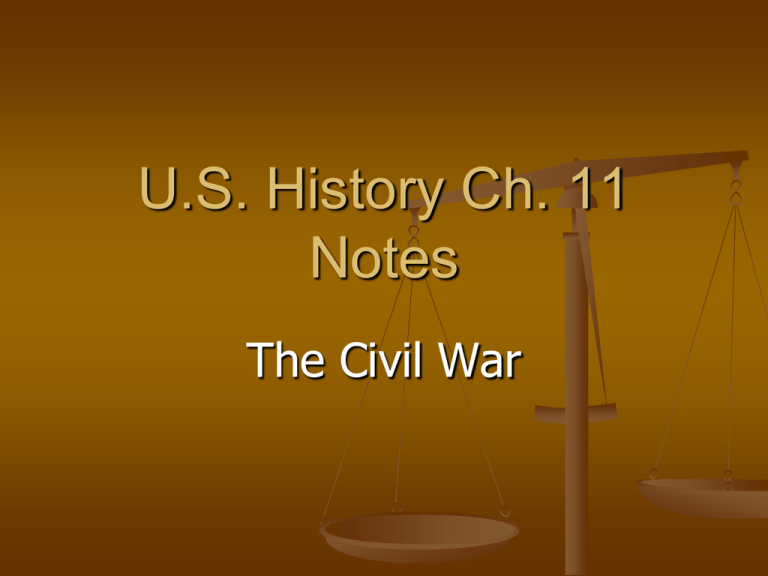
U.S. History Ch. 11 Notes The Civil War 1) Although the South had many experienced officers to lead its troops, the North had several economic advantages. 2) In 1860 the population of the North was 22 million while the population of the South was only 9 million. The North’s larger population gave it a distinct advantage in raising an army and supporting the war effort. 3) In 1860 roughly 80 percent of the nation’s factories were in the North. These factories produced more than 90 percent of the country’s clothing, boots, shoes, and pig iron essential for manufacturing weapons and equipment. 4) The South had only one factory capable of producing weapons (canons, etc…), the Tredegar Iron Works in Richmond, VA. 5) The North enjoyed several financial advantages. In addition to controlling the national treasury, the Union could expect continued revenue from tariffs. Many Northern banks also had large reserves of cash that they loaned the government for the war effort. 6) Another disadvantage for the South was the Confederate constitution, which emphasized states’ rights and limited the central government’s power. The commitment to states’ rights interfered with Davis’s ability to conduct the war. 7) The Union defeat at the first Civil War battle, the First Battle of Bull Run, made it clear that the North would need a large, welltrained army to defeat the South. 8) Early in 1862 Union general Ulysses S. Grant began a campaign to seize control of two important rivers within the Confederate States: the Cumberland and Tennessee rivers. 9) Control of the Cumberland and Tennessee rivers would cut Tennessee in two and provide the Union with a river route deep into Confederate territory. 10) Confederate forces launched a surprise attack on Grant’s troops, who were camped about 20 miles N of Corinth, MS near a small church named Shiloh. Grant rushed around the battlefield and assembled a defense that held off repeated Southern attacks. 11) The Battle of Shiloh stunned people in both the North and the South. 20,000 troops had been killed or wounded, more than in any other battle up to that point. 12) The Civil War began with an attack on Fort Sumter, a Union fort just off the coast of Charleston, SC. Not a man was killed in the attack. 13) The Battle of Antietam fought between Union forces under George B. McClellan and Confederate forces under Robert E. Lee was the bloodiest one-day battle in the Civil War. 6000 men were killed. 14) The Battle of Antietam was a crucial victory for the Union. If the Confederate forces under General Lee had won the British would have become involved in the war. 15) The South’s defeat at Antietam had a significant political impact in the United States. It convinced President Lincoln that the time had come to end slavery in the South. 16) Although most Democrats opposed any move to end slavery, Republicans were divided on the issue. Most Republicans were strong abolitionists, but some only opposed the further spreading of slavery. 17) On Sept. 22, 1862, encouraged by the Union victory at Antietam, President Lincoln publicly announced that he would issue the Emancipation Proclamation - a decree freeing all slaves after Jan. 1, 1863. 18) Pressed by the costs of the war, both the N and the S struggled to keep their economies working. The S suffered more from wartime inflation and critical shortages, while the N responded quickly to changes brought about by the war. 19) Due to the South’s struggling economy and food shortages as a result of the war, many Confederate soldiers deserted and returned home to help their families. 20) The North experienced an economic boom because of the war. Its growing industries benefited greatly from the wartime demands for clothing, weapons, and other necessities. 21) The Emancipation Proclamation officially permitted African Americans to enlist in the Union army and navy. Almost immediately African Americans rushed to join the military. 22) About 180,000 African Americans served in the Union army during the Civil War, roughly 9 percent of the army’s total soldiers. Another 10,000-15,000 served in the Union navy. 23) Among the 1st African American regiments officially organized in the th N was the 54 Massachusetts. The regiment fought valiantly at Fort Wagner near Charleston Harbor in July 1863, losing nearly half of its soldiers in the battle. 24) Disease was one of the greatest threats facing Civil War soldiers. In many cases, regiments lost half their men to illness before ever going into battle. 25) The Civil War was a turning point for the nursing profession in the U.S. The courage and energy shown by women also helped to break down the belief that women were weaker than men. 26) A vital part of the Union strategy in the Civil War was gaining control of the Mississippi R. If the Union could capture Vicksburg, MS, the last Confederate stronghold on the river, the North could cut the South in two. 27) Gen. Grant decided that the only way to take the city of Vicksburg was to put the city under siege – cut off food and supplies and bombard the city until its defenders gave up. 28) On July 4, 1863, with his troops starving, the Confederate commander at Vicksburg surrendered. Grant’s successful siege of Vicksburg divided the Confederacy in two as the Union gained control of the Miss. River. 29) The Battle of Gettysburg became the bloodiest and most famous of Civil War battles with 23,000 Union and 28,000 Confederate troops killed, and it proved to be the turning point of the Civil War. 30) In November 1863 President Lincoln dedicated a portion of the Gettysburg battlefield as a military cemetery. His speech known as The Gettysburg Address became one of the best-known orations in American history. 31) Lincoln rewarded Grant by appointing him general in chief of the Union forces following general Grant’s successes at the siege of Vicksburg and the battle of Chattanooga. 32) The Union Navy launched an operation to close the port of Mobile, AL, which was the last major Confederate port on the Gulf of Mexico east of the Mississippi R. 33) The Union navy didn’t completely capture Mobile in Alabama, but it did seal off Mobile Bay making it virtually impossible for the Confederacy to ship goods in and out of the Deep South. 34) In late August 1864 Union General William Tecumseh Sherman sent his troops south around Atlanta to cut the roads and railways leading into the city. Without too much effort Sherman was successful in capturing Atlanta. 35) After occupying Atlanta, Sherman proposed to march across GA. “I could cut a swath to the sea,” he explained, “and divide the Confederacy in two.” The march would be “a demonstration to the world…that we have a power that Davis cannot resist.” 36) Sherman ordered his troops to destroy everything in the city of Atlanta that was of military value, including railroads, warehouses, mills, factories, and machine shops. 37) On Nov. 15th, 1864, Sherman began his March to the Sea. His troops cut a path of destruction through GA that was in places 60 miles wide. 38) Lincoln won the election of 1864 and secured a 2nd term as President. With 55 percent of the popular vote he interpreted his reelection as a mandate to end slavery permanently by amending the Constitution. 39) Lincoln described his plan to restore the Southern states to the Union, and in the speech he mentioned including African Americans in Southern state gov’t. One listener, actor John Wilkes Booth, said to a friend, “That is the last speech he will ever make.” 40) The North’s victory in the Civil War strengthened the power of the federal gov’t over the states, brought a final end to slavery, and left the South socially and economically devastated. The years after the war would become known as the era of Reconstruction.
